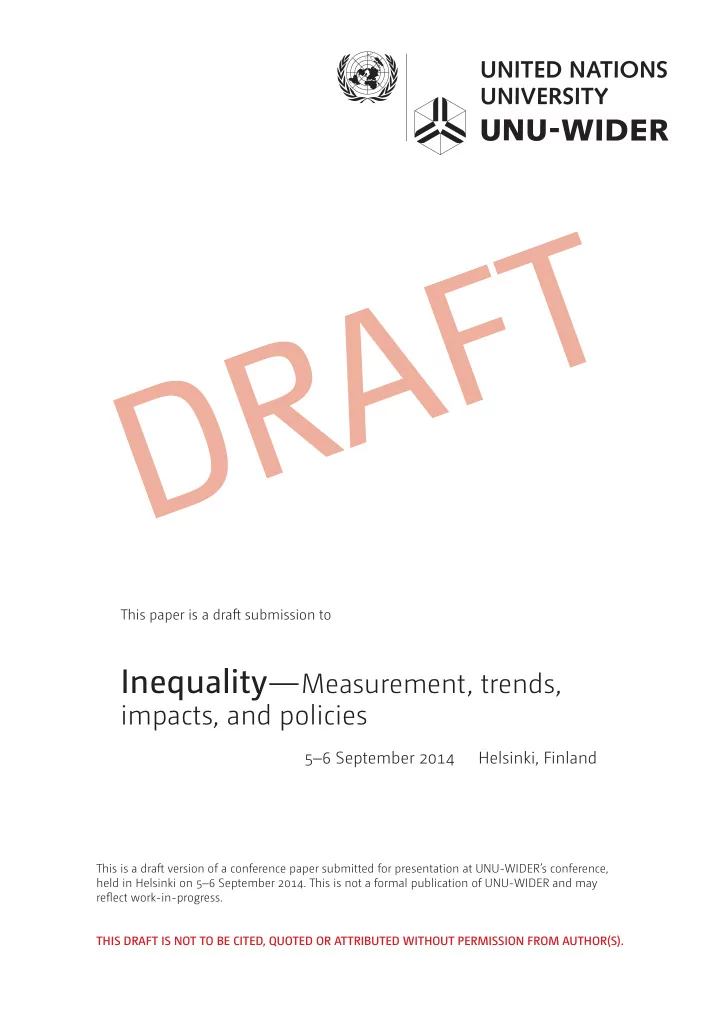

DRAFT This paper is a draft submission to Inequality — Measurement, trends, impacts, and policies 5–6 September 2014 Helsinki, Finland This is a draft version of a conference paper submitted for presentation at UNU-WIDER’s conference, held in Helsinki on 5–6 September 2014. This is not a formal publication of UNU-WIDER and may refl ect work-in-progress. THIS DRAFT IS NOT TO BE CITED, QUOTED OR ATTRIBUTED WITHOUT PERMISSION FROM AUTHOR(S).
Intrahousehold inequalities in child rights and wellbeing. A barrier to progress? Laura Rodriguez Takeuchi This paper attempts to measure the extent of inequality within households and its contribution to overall levels of inequality in child wellbeing. It analyses the distribution of outcomes between girls and boys for four indicators: nutrition, birth registration, school attendance and time spent doing work and chores, with data from the Multiple Indicators Cluster Surveys (MICS) for 20 developing countries. An L-Theil index is used to decompose inequality into the between and within-household components. We find that intrahousehold inequality is an issue in countries even when on the average there is progress towards child wellbeing. Across the four indicators of child wellbeing, intra-household inequality represents a significant proportion of total inequality, but with great variability across countries. The neglect of intra-household inequalities conceals the outcomes of those children who fare below their household average leading to a skewed view of the patterns of progress towards eliminating child poverty and the effective realization of their rights. JEL classifications D39; I3; D13 Keywords Inequality; intrahousehold; child; wellbeing; multidimensional 0
Key Messages • Inequality within households is rarely measured despite its analytical importance. A new methodology allows for its measurement between girls and boys in four indicators of child wellbeing: nutrition, birth registration, schooling and work hours. • Some disparities in child wellbeing are of important magnitude. Across 11 to 19 countries, the average Gini coefficient for school attendance is 0.18; it is 0.42 for birth registration, 0.71 for working hours and 0.76 for stunting. • Inequalities between boys and girls within households can be pronounced, ranging between nine and 63 percent of total gender based inequality, varying depending on the indicator, the country and the period. • It is not possible to eliminate child poverty without addressing disparities within households. Even when total and within-household inequalities are not large in absolute terms, or when average child wellbeing is high, intrahousehold inequalities are larger in relative terms and constitute the harder gaps to address to realise progress in child wellbeing. • Disparities inside households do not show a clear bias towards one or the other gender and the direction of the bias is not the same across indicators of wellbeing. In school attendance more households tend to favour girls, while in work time, they tend to disadvantage them. In some countries, girls are typically more disadvantaged within households, while in other cases boys are relatively more deprived. 1
Contents Key Messages .......................................................................................................................................... 1 1. Introduction .................................................................................................................................... 4 2. Measurement issues and methodology ......................................................................................... 6 2.1 Intra-household inequalities ......................................................................................................... 6 2.2 Child wellbeing and multidimensional inequality ....................................................................... 10 3. Results ........................................................................................................................................... 13 3.1 Nutrition-Stunting ....................................................................................................................... 14 3.2 Birth Registration ........................................................................................................................ 16 3.3 School attendance ...................................................................................................................... 18 3.4 Work hours (economic, domestic and chores) ........................................................................... 20 3.5 Intrahousehold inequality as a barrier to ‘get to zero’ ........................................................... 28 3.6 Is there evidence of systematic bias against boys or girls? When is intrahousehold inequality higher? .............................................................................................................................................. 29 4. Discussion and Conclusions .......................................................................................................... 31 References ............................................................................................................................................ 34 Appendix ............................................................................................................................................... 39 Appendix 1- Indicators ...................................................................................................................... 39 Appendix 2- Country sample ............................................................................................................. 40 Appendix 3- Summary statistics ........................................................................................................ 41 Appendix 4- Direction of the bias within households ....................................................................... 45 Appendix 5- Cross tabulations .......................................................................................................... 49 Appendix 6- Measures of association by country ............................................................................. 52 List of boxes, figures and tables Box 1 - Measuring gender intrahousehold inequalities .......................................................................... 7 Box 2- Household-level variable: Stunting .............................................................................................. 8 Box 3 - Measuring inequality in multidimensional poverty .................................................................. 12 Figure 1 - Child poverty approaches: three models .............................................................................. 11 Figure 2 - Average levels and inequality in stunting ............................................................................. 15 Figure 3 - Inequality decomposition. Stunting ...................................................................................... 16 Figure 4 - Average levels and inequality. Birth registration .................................................................. 17 Figure 5 - Inequality decomposition. Birth registration ........................................................................ 18 Figure 6 - Average levels and inequality. School attendance ............................................................... 19 Figure 7 - Inequality decomposition. School attendance ..................................................................... 20 2
Figure 8 - Average levels and inequality. Working hours ..................................................................... 22 Figure 9 - Inequality decomposition. Working hours ........................................................................... 23 Table 1-Child wellbeing dimensions, indicators and data availability .................................................. 11 Table 2 - Stunting Inequality (15 countries) ............................................. Error! Bookmark not defined. Table 3 - Birth registration- Inequality (19 countries) ............................. Error! Bookmark not defined. Table 4 - School attendance- Inequality (18 countries) ........................... Error! Bookmark not defined. Table 5 - Work time- Inequality (11 countries) ........................................ Error! Bookmark not defined. Table 6 - Direction of inequality with higher levels of wellbeing ......................................................... 28 Table 7 - Cross tab. Stunting and birth registration .............................................................................. 30 Table 8 - Measures of association ......................................................................................................... 30 3
Recommend
More recommend